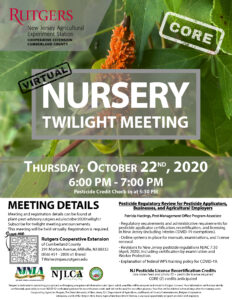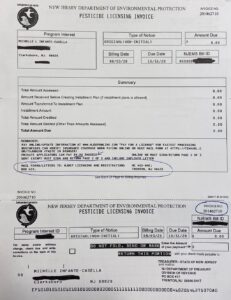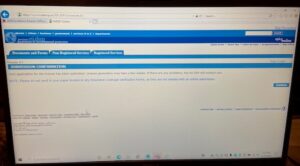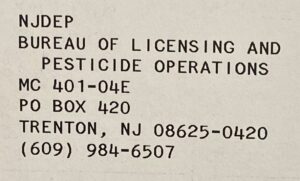Thursday, October 22nd, 2020
6:00-7:00 pm
Click here to register for the twilight meeting
Registration password: nursery
Click here to upload your government issued Photo ID and Pesticide License prior to the meeting
Please join us for a CORE (2) credit bearing session where Pat Hastings will be discussing regulatory requirements for pesticide applicator certification, recertification, and licensing in New Jersey. Administrative changes to certification, recertification, and license renewal processes in New Jersey; includes interim COVID-19 exemptions. Will walk through use of online systems in place for manuals, examinations, and license renewal; resource guide with links provided. Revisions to New Jersey pesticide regulations NJAC 7:30 (April 2020), including certification by examination and Worker Protection. Special emphasis on key differences for ag employers and trainers between NJ regulations and 2015 federal Revised Worker Protection Standard. Explanation of federal WPS training policy for COVID-19. A handout: Resources for New Jersey Licensed Pesticide Applicators will also be made available.
Note: If you uploaded materials for the September Nursery Twilight you do NOT need to for the October meeting.
Upload directions: If you click on the photo ID upload link using a smart phone/tablet you will have the option of simply taking a photo of your ID and uploading it directly into the system. Otherwise, you can scan a copy of your photo ID into a computer and follow the directions at the upload link. If you are unable to upload documentation prior to the meeting, please contact Tim Waller for assistance (twaller@njaes.rutgers.edu).
October 2020 Nursery Crop Twilight Meeting (CORE)
NJ Pesticide License Recertification credits anticipated: CORE (2)
Online Program
5:30pm Webinar opens and visual attendance check
–Timothy Waller, Rutgers Cooperative Extension Agriculture Agent for Cumberland County
(Recording begins) : Welcome Remarks
6:00pm Pesticide Regulatory Review for Pesticide Applicators, Businesses, and Agricultural Employers
-Patricia Hastings, Extension Pesticide Safety Education Program Coordinator
(Recording ends)
7:00pm Additional questions; Adjourn
In cooperation with the NJNLA, NJLCA, and NJCTGA
Instructions:
- Register for event at the above link
- Include your pesticide license number and date of birth if you would like recertification credits
- After registration you will receive a confirmation email with a link to the actual twilight meeting.
- Upload a copy of your government issued photo ID and pesticide license at the link above
- Day-of: click the link in the registration confirmation email and select “join by browser-New” around 5:30pm
- Day-of: Have your video on if you wish to obtain credits
Required to be eligible to receive pesticide applicator recertification credits for this twilight program:
1. Attend the entire meeting with live VIDEO feed on, seated in the center of the frame. Those without a webcam or phone attendees without a live video feed are not eligible to receive credits. Call-ins (audio only) are not eligible for pesticide recertification credits as of now; you need a computer/phone/tablet with *live* video capability. If you choose to access via your smartphone, it is recommended that it is fully charged or plugged in; and that any background applications are not running.
2. Attendees must participate throughout the entire session, staying to the end. Individuals are not eligible for credits if they arrive after the start of the first training topic or leave before the end of the last topic. Polls will be randomly scheduled, and attendance will be visually monitored to verify attendance.
3. In order to meet NJDEP-required identity verification requirements, each attendee must provide a copy of a Government issued photo ID (passport, driver’s license, municipal, or county ID) and their New Jersey Pesticide Applicator License as part of their registration.
Please upload files of your photo ID and applicator license to the link above as;
a) “Last name_ First_ Photo ID”
b) “Last name_ First_ Pesticide License”
Note: Licensed applicators with a recertification period expiring October 31, 2020 or October 31, 2021 will be given an exemption from the NJDEP online credit cap of 25% and are eligible for all credits, otherwise this exemption does not apply.
Rutgers is dedicated to protecting your privacy and keeping your personal information safe. Upon upload, your files will be encrypted and stored to Rutgers Connect. Your information will be kept strictly confidential; used solely to meet NJDEP ID verification protocol for recertification credit; and will not be used for any other purpose. Your files will be deleted within 60 days after the training event.
 Rutgers Cooperative Extension Agricultural Agents have been receiving questions from farmers on what to do with the renewal applications they recently received from
Rutgers Cooperative Extension Agricultural Agents have been receiving questions from farmers on what to do with the renewal applications they recently received from 

